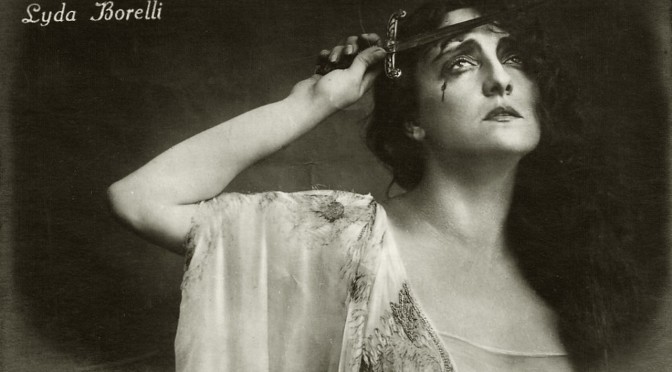This is a guest post for Silent London by David Cairns, a film-maker and lecturer based in Edinburgh who writes the fantastic Shadowplay blog.
The so-called “Italian diva” school of silent cinema presents challenges for those in love with narrative and closure, and not just because many of the films are incomplete or untranslated. These movies seem genuinely less concerned with plot than surrounding national cinemas, though this assertion must be qualified in a number of ways.

What the films definitely are obsessed with is their stars, such women as Lyda Borelli, Francesca Bertini, and Pina Menichelli, around whom the films revolve, wholly. It’s as if the Italians noted that stars seemed to be what the public cared for most, and so decided to put everything else on the back burner while serving up long, langurous shots of languishing, anguished beauties. Superficially resembling both the kohl-daubed vamps of the Theda Bara school, and the later Swanson type of clothes-horse drama queen, Borelli and her sisters in sin dominated their films in a way few stars have been allowed to. Dietrich, maybe, or Garbo, but even those screen queens had to make way for plotting and forward momentum.

Movies such as Malombra (1917, which played at this year’s Il Cinema Ritrovato festival in Bologna) and Rapsodica Satanica (1915) do still require a central narrative premise and a semblance of progression, but this always feels more like an excuse for the star (Lyda Borelli in these two films) to mess about with their flowing locks, put on and take off veils, thrash around in the throes of (possibly supernatural) passion, go mad, or somnambulate around elaborate upper-crust sets. This evocative dramaturgy/thaumaturgy may be kickstarted by, you know, actual story events, but it soon takes over the film’s gimlet-eyed attention and may simply repeat itself with variations until the film runs out.

Malombra is based on a novel, but leaves much of the plot obscure, either because it seemed uncinematic (people explaining things: bad. Borelli wafting fabrics about: good) or because of the two reels still missing. But I bet the two reels, if we could see them, would just consist of Borelli striking poses and straining her long, sinuous neck. There’s a decent ’40s remake, which reduces it all back down to a simple Gothic formula (“girl moves into old dark house and gets the pants scared off her”). Whereas Malombra was described in Bologna by one of its loving restorers as a cinematic “path not taken,” a Lynchian exercise in mood, mystery and ambiguity. Is Borelli’s character insane or possessed? We shouldn’t try to decide, we should just inhabit the dark gulf between the two possible interpretations, exulting in the crepuscular dreamworld through which Borelli swansons her way.
These films, once so popular (perhaps the closest movies came to having their stars literally sit and read the phone book), fell into total obscurity until revived in the 1990s, when they suddenly illuminated modes of performance and storytelling (or anyhow, time-based physiognomic and scenographic observations). The 1999 compendium film Diva Dolorosa in a sense fulfils the movies’ natural inclinations by compiling the most exotic, erotic, tortured and trance-like moments together into a single, plot-free wallow in celluloid mirage.

Reblogged this on ithankyouarthur.